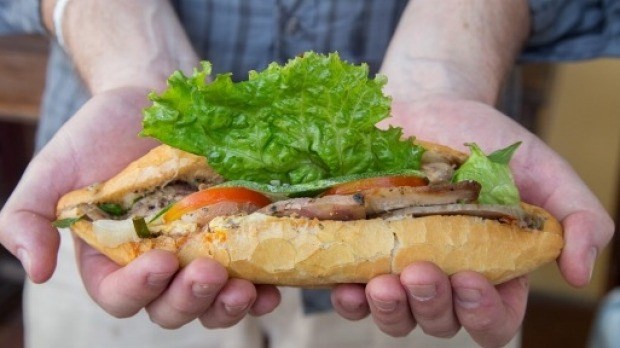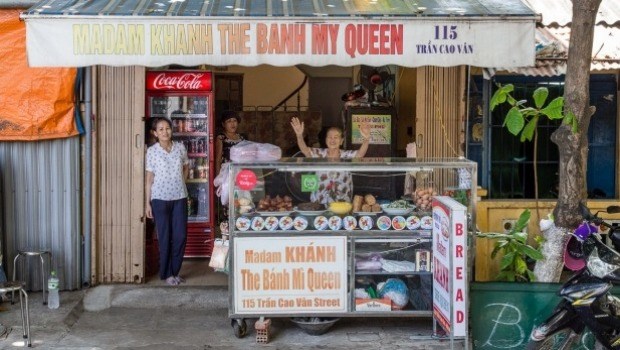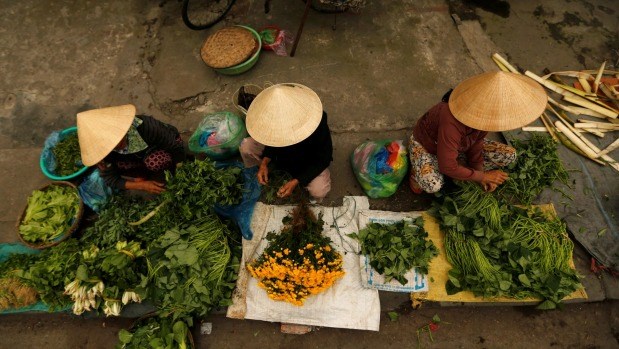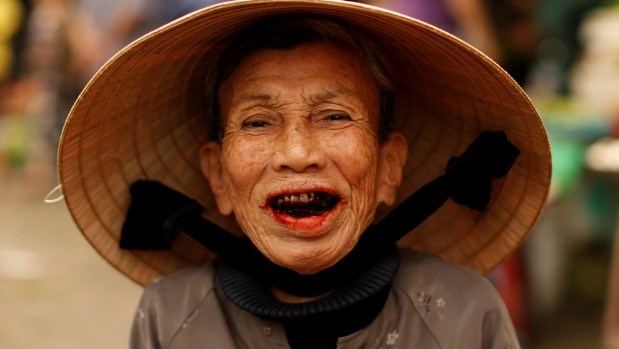The queue
in front of me spills out onto the street...

Have you ever seen a better-looking sandwich? Photo of Emma Byrnes/Fairfax
We
are at Madam Phuong Banh Mi restaurant in Hoi An, a small town in Quang Nam
Province, on the country's central coast. The old quarter of this former
Chinese and Japanese trading port is heritage-listed and in excellent
condition, thanks to co-operation on both sides during the American war.
Today,
squadrons of cyclo drivers pedal selfie-stick wielding tourists down its
enchanting, narrow streets. An array of tailors and dressmakers tout the same
holiday makers pot luck replicas of famous fashion labels and strings of
colourful bamboo lanterns hang everywhere (also for sale, if you're
interested).

The queen of banh mi. Photo of Emma Byrnes/Fairfax
But
Hoi An is increasingly drawing visitors for its food. Although a long way from
the rich Mekong River food bowl in the south, this relatively sleepy town has
developed a reputation for local delicacies, such as translucent "white
rose" dumplings, pork cao lau noodles and com ga (chicken rice); decent
local and tourist-friendly restaurants and cooking courses abound here, too.

Hoi An is growing in popularity as a foodie destination. Photo of 123RF
An
accompanying surge in food blogging, travel apps and social media now means
visitors are eager to ensure they can boast about having tried the
"best" place for this dish or other.
Consequently,
trails to certain street food vendors increase, driving more tourist traffic,
leading to more Instagram posts and so it goes.
Which
brings us back to Madam Phuong's. If you ask a taxi driver where the best banh
mi in Hoi An is they will mention this spot at 2B Phan Chu Trinh Street and one
other: Madam Khanh "The Banh My Queen", an octogenarian who owns a
popular stall at 115 Tran Cao Van Street.

Women wearing traditional hats, known as a non la, sit in a market in Hoi An. Photo of Jorge Silva/Reuters
Banh
mi eaters are divided as to which is better, although on the internet, Madam
Phuong generally wins out, thanks to a mention on Anthony Bourdain's No
Reservations television series (he described her banh mi with the lot as a
"symphony in a sandwich").
When
I finally make my way to the front of the queue I am confronted by five ladies
working in seemingly fast motion behind a glass counter.
They
diligently avoid eye contact as they put together orders in a blur of
chopsticks and ingredients: pate, mayonnaise, coriander, pork cold cuts,
roasted pork, pickled daikon and carrot, chilli, sauces and, of course, stacks
of golden bread rolls.

The Vietnamese make the best sandwiches in the world. Photo of Jorge Silva/Reuters
As
tourists pose for photos with their famous sandwiches, I smuggle mine outside,
away from the gastro-paparazzi.
Biting
through its brittle outer crust it shatters, giving way to a fluffy white,
almost otherworldly interior.
Flavours
zip and sing on my palette – savoury pork, fresh coriander, crunchy cucumber –
and then the chilli hits, like an old, welcome sparring partner. It's good.
It's very good. But is it the best?
Literally
translated, banh mi means "bread" or "wheat cake". What
most Westerners recognise as a Vietnamese pork sandwich here is called banh mi
thit ngoui ("bread, meat and cold cuts") or banh mi dac biet
("the special"). Its evolution is a fascinating tale, spanning
Vietnam's French colonial past and three bloody conflicts.
In
a condensed version of a 10,000-word treatise on the subject ("The
Sandwich That Ate The World", published in digital travel magazine Roads
& Kingdoms), writer Simon Stanley traced the modern origins of banh mi to
an address in Ho Chi Minh City's District 3. Run by a Hanoi family who fled to
the southern city (then known as Saigon) when the country divided in 1954, Hoa
Ma is believed to be the first banh mi shop to reduce the size of their rolls
to the now familiar 20 centimeters; they also substituted vegetables for
expensive meats, to make the sandwiches more affordable for Saigon's working
men and women. "It's a leap to say that they invented the banh mi,"
says Stanley, 33, who was born in London but now lives in Saigon. "But I
think as far as what you see and eat today, it's very likely that they started
putting that together first."
Stanley's
research shows that the banh mi story truly began when the French arrived in
Saigon, in 1859. Along with military rule, they brought French cuisine,
although for many years European food was strictly for the European rulers, who
believed that meat and bread kept them "stronger" than their Asian
subjects, who lived mostly on a diet of fish and rice. A popular dish at the
time was known as casse-croute ("to break the crust"): a traditional
French baguette served with a plate of cold cuts, pate, ham, cheese and butter.
This was the deconstructed precursor of the modern banh mi.
In
1914, World War I changed everything. First, the two German-owned main
importing businesses in Saigon were seized and for the first time cheap
European foods – cheeses, meats and bread – flooded the local (non-European)
market. Second, war disrupted shipping lines, making these staples increasingly
hard to come by. Industrious Vietnamese people responded by baking their own
bread. Soon, everyone was hooked on wheat.
Andrea
Nguyen, a Vietnamese American chef and author of numerous books including The
Banh Mi Handbook, says the buns baked in Vietnam today are much lighter than
those early offerings. "And also, there are these additives in the flour
and the dough that Vietnamese bakers learned to use over the years because they
needed that dough to rise in tropical humidity," she says. Today, you'll
see banh mi sellers around the country taking multiple deliveries of fresh
rolls during operating hours, which are typically for a few hours in the early
morning and again in the late afternoon.
The
common claim that rice flour is the magic ingredient that makes the rolls
fluffy is a myth, says Nguyen. While wheat flour may sometimes be
"cut" with less expensive rice flour to save money, its gluten
properties are more likely to make the bread heavier in texture.
Back
in Hoi An, I cycle through the backstreets to sample Madam Khanh's famous banh
mi. It is a completely different beast: rich and hearty, it oozes a kind of
gravy sauce that runs down my arm as I eat. It's delicious, but as I wipe the
grease from my chin I wonder, "Is it better than Madam Phuong's?"
In
truth, the perfect banh mi is a kind of mirage. After three months of
travelling the country, the best sandwich I taste is from a roadside vendor in
Danang. We had just arrived by plane and had somehow managed to skip lunch, so
this crunchy, chilli-laced mini-missile was, well, perfect. But I won't tell
you the address (it was near the beach). Instead, I encourage you to go in
search of your own, personal banh mi. It's a lot of fun, and tastier, too.
FIVE OF THE BEST BANH
MI IN VIETNAM
1. Madam Phuong Banh
Mi, 2B Phan Chu Trinh Street, Hoi An
A
fresh-looking roll, popular with Western tourists because it featured on
Anthony Bourdain's No Reservations television series.
2. Madam Khanh
"The Banh My Queen", 115 Tran Cao Van Street, Hoi An
A
rich, sauce-heavy roll that leads to messy but extremely satisfying eating.
3. Hoa Ma, 53 Cau
Thang Street, District 3, Ho Chi Minh City
Come
here to pay homage to what may be the origin of the modern banh mi.
4. Nhu Lan, 66 Ham
Nghi Street, District 1, Ho Chi Minh City
This
popular bakery is perfect for trying your first Vietnamese-made banh mi.
5. Banh Nam, 151A Xo
Viet Nghe Tinh Street, Binh Thanh District, Ho Chi Minh City
The
future of banh mi? Modern, sleek shop fit-out but traditional recipes.
STAY
In
Hoi An we stayed at several homestays, the best of which was Palm View Villa, a
small, four-room property with a pool, within 15 minutes bike ride of the old
town.
Rooms
start from $US45, phone +84 510 3 922 227 or see palmviewhoian.com.
In
Ho Chi Minh City we stayed at Huong Sen Hotel, a three-star hotel with a pool
in the centre of the city.
Double
rooms start from VND 2,100,000, phone +84 838 291 415 or see
huongsenhotel.com.vn
* Peter Barrett
travelled at his own expense.
By Traveller/Stuff